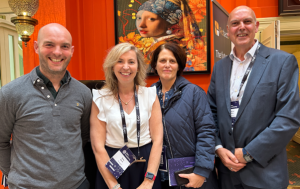iProtectU Feature in Irish Health and Safety Review
Earlier this year our team sponsored and presented at the Ibec conference. For more information about the presentation and conference https://iprotectu.com/iprotectu-present-a-buyers-guide-to-digitalising-osh-the-software-provider-perspective-ibec-osh-seminar-2024/
Ibec are Ireland’s largest lobby and business representative group. The seminar explored solutions, practical case studies, best practice, compliance considerations and emerging policy developments. The event was highly informative and well represented by safety proffessionals, industry decision makers and policy influencers.
The following story featured this month in the Health and Safety Review. For the full article please visit https://www.healthandsafetyreview.ie/article/8708
Embracing technology was the theme of Ibec’s annual occupational safety and health seminar, which focused on how digital tools and platforms can make the role of the safety professional easier.
by Margaret Kirby - Health and Safety Review
Elaine Bowers, senior Environmental, Health and Safety (EHS) executive with Ibec, welcomed a large turnout of industry leaders, EHS professionals, regulators and innovators to Barberstown Castle, Co. Kildare, on October 26th. Showcasing the best in digital technology and tools specifically for managing health and safety, this event encompassed everything one needs to know when trying to identify what technology works best.
Opening the event, Minister Emer Higgins, Minister of State for Business, Employment and Retail, acknowledged the important work of those who manage safety. “Your work prevents avoidable risks”, she said.
Minister Higgins has a unique background. Having worked in small Irish businesses, one of which was in the chemicals business, she has an appreciation of the value in staying up to date with current information in health and safety (Refer to interview with Minister Higgins in the October 2024 issue of HSR. Link: https://www.healthandsafetyreview.ie/article/8708
Award for making a difference
Acknowledging one person who has enabled the health and safety community to stay up to date, an award was made to Health & Safety Review’s editor, Herbert Mulligan. “This is Ibec’s first award to recognise someone who has made an exceptional difference in health and safety” Elaine said.
Mr. Mulligan has been the recipient of awards in the past. He was awarded the National Irish Safety Organisation (NISO) ‘Roll of Honour’ title in 2008, and the Institution of Occupational Safety and Health (IOSH) ‘Person of the Year’ award in 2009.
Praising the Health & Safety Review publication, Michael Gillen, head of occupational safety and health at Ibec, added the journal and website saved time for professionals by prioritising and distilling what can be complex information.
Continuing the theme of the conference, Mr. Gillen reminded the audience that Ireland is leading the way in technology. Remaining focused on the people designing, using and implementing the technology is important, he said.
Fines and breaches
This message was echoed throughout the day by other speakers, one of who was Aoife Coll, senior associate technology and innovation with Arthur Cox law firm.
Ms Coll relayed to listeners the risks involved in non-compliance with regulations concerning information about people. This is relevant in the context of any safety technology which captures data on its employees. The seven principles of the General Data Protection Regulation (GDPR), as explained by Ms Coll, need to be at the forefront of EHS professionals’ minds when turning to technology solutions.
Lawfulness, fairness, transparency, purpose limitation, data minimisation, storage limitation, integrity and confidentiality, and accountability, were named. “You need a legal basis to process data, she explained”.
Giving examples of what can go wrong, she called out scenarios where significant fines were handed out to large employers for breaches in GDPR legislation. Meta Platforms, formerly named Facebook, was fined €17 million by the Data Protection Commission, for a series of data breaches in 2022. This was followed by a €1.2 billion fine in 2023, which is the largest GDPR fine ever.
Trust in technology
Moving onto the subject of psychological considerations when using technology, Patricia Murray, senior work and organisational psychologist with the Health and Safety Authority (HSA), emphasised the importance of trust. People need to trust the technology, and the technology needs to be trustworthy, was the key takeaway message, in particular if the technology is accusing users of something.
An example of technology wrongly accusing users was when thousands of innocent postmasters in the British Post Office were accused of financial shortfalls, with hundreds wrongly prosecuted, due to failures in their IT system.
During her talk, Ms Murray stressed the need for employers to engage with their employees before implementing new technology and explain the ‘why’ it would be useful to them. She said that people need to feel heard and recognised, or they would be less likely to follow systems at work.
Scalability and integration
Implementing new technology requires a level of planning and foresight, and Wayne Beck of iProtectU, providers of governance, risk and compliance software, took delegates through some key factors to consider. “It’s a complex market”, he said, and it can be difficult to decide what to choose. Compliance is the main reason for companies implementing software packages, he said, and it’s important to involve the right people from the very start.
Key stakeholders include Human Resources (HR) and IT, he said. Always ask for a quotation upfront and avoid long term contracts. “If you get it wrong at the start, you may end up stuck with it for longer than you’d prefer”, he explained. Ask questions and gather as much information as you can, before you purchase, he advised. For example, does the platform have a dedicated server infrastructure or an aggregate server? Dedicated is preferable, he suggested, for cyber security reasons.
Managing cyber security is a real priority, Mr Beck noted. Ask how this will be managed, what happens if there is a cyber-attack and how far back can you go to retrieve data if it does happen? Consider scalability and integration, he said. Your organisation may be a certain size now, but what happens in five years’ time – will the platform be able to accommodate more data and more users
Trinity College experience
Once the decision is made on what technology to purchase, the next stage is implementation. Katharine Murray, head of safety with Trinity College Dublin, took the audience through the practical aspects of this. Interviewed by HSR last year (article link: https://www.healthandsafetyreview.ie/article/8334, she outlined three pieces of technology which have helped to make the safety role at Trinity easier.
The first was software provided by iProtectU. She explained their initial focus was on training. “With the use of online training we have definitely become more efficient and have a wider reach”, she said. Since then, they have branched into other features offered by the software, including risk assessment and incident management.
The second tool is ‘Safezone’, a free-to-download app for staff and students, which is ideally suited for those who are working alone or feeling vulnerable. The third tool is ‘Labcup’, which is a chemical inventory and laboratory management tool. Advising the audience on learnings from the implementation process, Katharine recommended the value in having a project manager with IT experience involved in the process.
Data is key
Ed Harnett of Habitus Health, providers of AI (Artificial Intelligence) supported manual handling and display screen equipment assessments, and mental health support, called out the benefits of real time data, which he said, “allows us to act in a preventative mode, not a reactive mode”. Referring to research, he said the highest performing companies are those with mature digital health and safety platforms.
Moving onto the topic of how to move an organisation from a compliance safety culture to a sustainable culture using technology, Mark Kidd of Safe 365 offered some insights. Measuring safety culture is key, he said. Suggesting how to do this, he spoke about their assessment and analysis tool, which puts a quantitative value on 82 elements which they have identified from research and global best practice, as being critical to embedding a mature culture.
Another advocate for gathering data was Greg Ramsbottom, head of EHS at Primark Stores. He talked through the challenges and benefits of implementing digital technology at their retail outlets. Highlighting the difficulties of paper-based and manual systems for recording and reporting incidents, he praised the implementation of a system which gives them the data they need.
The PINS (Primark Incident Notification System) now provides real-time data, instant notifications, and easily tracks trends. Whilst a gamechanger for managing data, person-to-person communication is still important, advised Greg, who said that “you may still need to pick up a phone” after an incident.
The last to speak was Tobba Vigfusdottir of Kara Connect, who travelled from Reykjavik for the seminar. New research, she said, shows that hybrid and remote workers are at risk of isolation and loneliness. The increased use of digital technology has also triggered an increase in mental health issues. Tobba added that those who struggle the most will not speak to their manager, and that building appropriate employee wellbeing supports was essential in the workplace.U

















